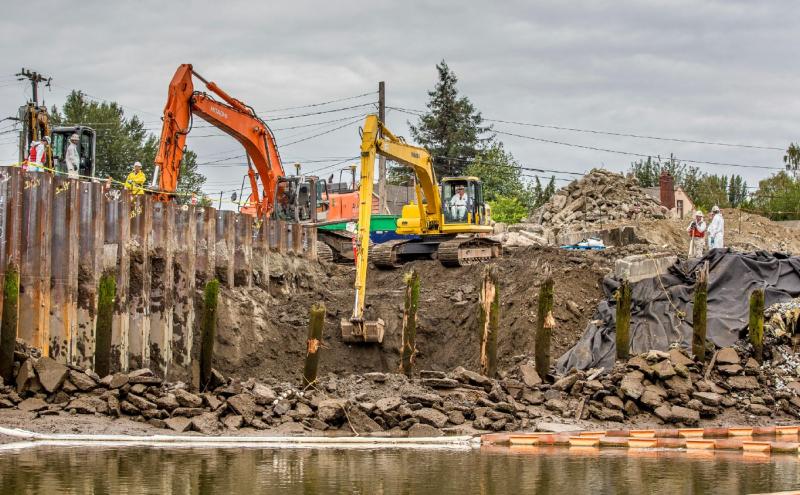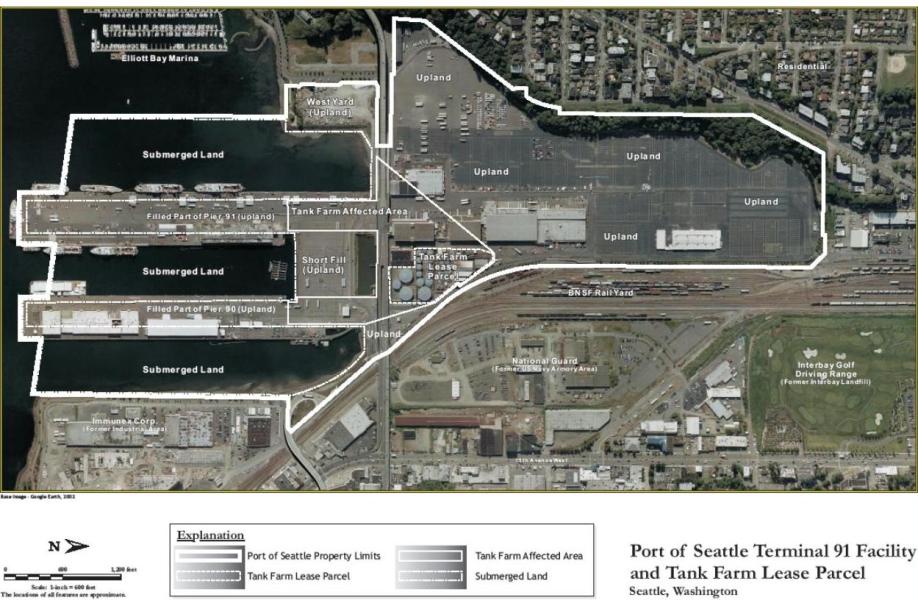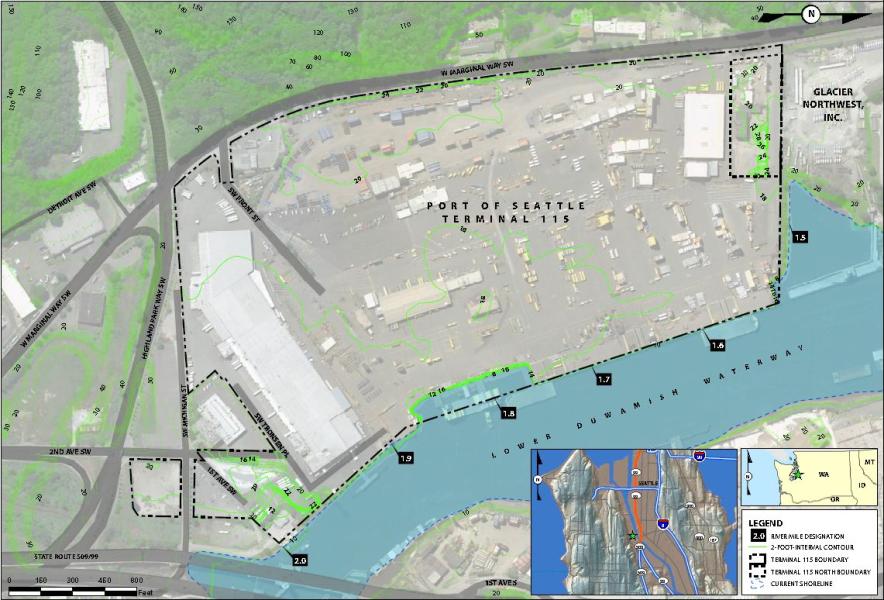
Learn more about the Port's active cleanup projects below. Contact information for each project is provided.

Learn more about the Port's active cleanup projects below. Contact information for each project is provided.
Terminal 91 (T-91) is an a 210-acre site located at 2001 West Garfield Street in the Interbay neighborhood of Seattle, Washington. The property consists of an upland area, two piers (Piers 90 and 91), and submerged sediment around the piers. The site is currently used as a cruise ship terminal, and for tug and large vessel moorage, commercial fishing vessel offloading and moorage, and seafood cold storage. There is also a business complex with various storage areas.
The Great Northern Railroad began to develop the area in the late 1890s by filling the area between Magnolia and Queen Anne. In 1913, the Port purchased property from the Great Northern Railroad to create T-91. Pier 90 was constructed in 1913, and Pier 91 was constructed in 1919; they were designated as Piers 40 and 41, respectively, and were the largest earth-filled commercial piers in the world at that time. Piers 90 and 91 were originally used for loading and unloading materials such as lumber, steel, and coal and for storing vegetable oil. The Port operated T-91 from 1913 to 1942.
From 1942 to 1976, the United States Navy took over T-91 as a naval station and expanded the boundaries to include all the property that is there today. The Navy sold the property back to the Port in 1976.
In addition to the Piers, a 4-acre tank farm was constructed in the 1920s and leased by the Port to various tenants for fuel storage until the Navy took over the tank farm as a fuel and lubricating oil transfer station. From the late 1970s until 1995, the tank farm served as a waste oil recovery and wastewater treatment and storage facility. It was demolished in 2005 after being used for fuel storage and blending from 1995 to 2003.

Historical industrial practices at T-91 contaminated the sediment and groundwater with gasoline and heavy oil range petroleum hydrocarbons, metals (arsenic, cadmium, chromium, copper, lead, mercury, silver, and zinc), phthalates, semi-volatile organic compounds (SVOCs), poly-aromatic hydrocarbons (PAHs), polychlorinated biphenyls (PCBs). Discarded military munitions were also discovered in the sediment at T-91 in 2010.
The entire T-91 facility is regulated by the Department of Ecology (Ecology) under a Dangerous Waste Management Permit. This includes corrective action requirements under the federal Resource Conservation and Recovery Act (RCRA) to address contamination at hazardous waste treatment, storage and disposal facilities. The Port has conducted several site investigations and cleanups under these requirements.
The upland cleanup of soil and groundwater has been completed, and the groundwater continues to be monitored to confirm that cleanup goals are being met.
The sediment remedial investigation was completed in December 2023. A sediment feasibility study is underway and will be completed in 2026. The Department of Ecology is expected to issue a Cleanup Plan by the end of 2026, following a public comment period. The Cleanup design will be conducted in 2027, with cleanup itself beginning in 2028.
Joanna Florer | Senior Environmental Program Manager | [email protected]
Visit Ecology’s Terminal 91 Cleanup Site page for more information.
Terminal 25 (T-25) South is on the southeast bank of the East Waterway at 2917 East Marginal Way South in Seattle. The T-25 South Site includes approximately 5 acres of upland area and 5 acres of submerged and intertidal areas. The in-water portion of the site contains a derelict pier structure with creosote pilings. The Port currently leases the portions of the upland T-25 South Site to various tenants who use the area for equipment and material laydown, light industrial activity, and truck parking.
Terminal 25 South industrial use dates to the original filling of the intertidal lands in the early 1900s, when the Duwamish River was reconfigured to the current channel location. The site was used for cold storage, logging facilities, and as a sawmill during the early 20th century. The sawmill was removed to allow for lumber storage and automobile staging in the early 1960s. The Port acquired the site in the late 1970s. During the 1980s, it was used for cold storage, seafood processing, and shipping operations. Most structures and buildings at the site were demolished in the 1990s.
The primary contaminants of concern are PCBs, dioxin and furans, and petroleum hydrocarbons.
The Port plans to create a habitat site here but needed to conduct cleanup in conjunction with building habitat.
After the cleanup, the Port will create critical fish and wildlife habitat. This large-scale restoration project supports recovery of the endangered Southern Resident killer whales (SRKW) population by significantly increasing habitat critical to abundance and health of Chinook salmon, the primary food source for the SRKW. The goal is to restore estuarine wetland functions across the site as well as to restore and create riparian habitat and off-channel rearing and refuge habitat for salmonids and other migratory and resident fish and wildlife in the East Waterway. The project will ultimately re-establish approximately 10 acres of riparian, emergent marsh, mudflat, and subtidal habitat.
The sediment, soil, and ground water investigation were completed in the spring of 2024. After submitting an engineering evaluation/cost analysis to the EPA in the fall of 2024, the Port anticipates receiving the EPA’s cleanup approval by 2026.
Joanna Florer | Senior Environmental Program Manager | [email protected]
The Site is located along East Marginal Way on the east shore of the Lower Duwamish Waterway (LDW) on approximately 20 acres of property,. The Site address is 4525 Diagonal Avenue South, Seattle, Washington. The Site consists of 2 parcels owned and managed by the Port: the West Parcel (9 acres) and the East Parcel (11 acres). The East Parcel is currently leased to ConGlobal Industries. The primary activities on the ConGlobal lease property include container storage, repair, and chassis storage. The West Parcel is currently not occupied by a tenant but is used for material storage. A Port public access and habitat mitigation area (sbəq̓ʷaʔ Park and Shoreline Habitat) is located along the southern shoreline of the West Parcel, adjacent to the LDW.
Prior to the channelization of the Duwamish River in the early 1900s the Site was an undeveloped tidal marsh. In 1972 the City sold the property to Chiyoda Corporation International for construction of a chemical manufacturing plant. Chiyoda’s manufacturing plant was never constructed; however, Chiyoda did complete Site preparation work including dredging along the shoreline and removal of previously abandoned sewage treatment plant structures. Chiyoda also leased the property to the Army Corps of Engineers to store and treat approximately 10 million gallons of hydraulically dredged sediment slurry from the cleanup of a 1974 polychlorinated biphenyl (PCB) transformer fluid spill in the LDW.
The Port acquired the property from Chiyoda in 1984 and divided the property into two parcels in 1985. Chevron USA Products Company (Chevron) purchased the East Parcel from the Port in 1985 with plans to construct a petroleum distribution terminal. Chevron’s terminal was never constructed; however, Chevron did use the property to stockpile and land farm petroleum-contaminated soil. Chevron owned the East Parcel until 1992, when it was conveyed back to the Port.
The Port leased the West Parcel to Lafarge Cement Company for use as a bulk cement terminal from 1989 to 1998. In the early 1990s, the Port redeveloped the East Parcel for use as a container storage yard.
The Site is the historic location of one of the City’s first wastewater treatment plants, serving the residential and industrial areas of several south Seattle neighborhoods including SoDo, Beacon Hill and Georgetown. The plant closed in 1970, and their structures were demolished soon after; however, several acres of sewage sludge was left as fill across much of the Site. Following the plant closure, the Site supported a few other owners and site uses until the Port purchased the property in the 1900s. In 1996, the Port redeveloped the entire east parcel of the property into its current layout and use – off-dock container terminal storage and repair for empty shipping containers. The primary contaminants of concern are related mainly to the use of sewage sludge as fill, and include PCBs, heavy metals, and petroleum.
The site’s history of industrial operations led to the significant contamination of the Site’s shallow soil and groundwater. This cleanup will not only protect human health for site and utility repair workers but also prevent recontamination of the adjacent waterway.
This cleanup is being conducted under an Administrative Settlement Agreement and Order on Consent (ASAOC) between the U.S. EPA and the Port of Seattle, City of Seattle, and King County. The ASAOC requires an Engineering Evaluation and Cost Analysis (EE/CA) investigation and report for the Site.
The EE/CA investigation was completed in late 2024. We are currently working on the EE/CA report and expect to have that completed by the summer of 2026.
Roy Kuroiwa | Environmental Program Manager | [email protected]
Visit the Terminal 108 Project page for more information.
Terminal 30 (T-30) is a 33.9-acre property addressed at 1901 East Marginal Way South in Seattle, Washington. The Site is located on the shoreline of the East Waterway near the mouth of the Lower Duwamish Waterway (LDW). T-30 is bound by terminal property to the north, East Marginal Way South to the east, a vessel slip to the south, and by the East Waterway to the west. The cleanup Site is comprised of one large and one small area totaling approximately 11 acres located in the northern portion of the property. T-30 currently operates as a freight terminal and provides shipping container storage.
Prior to the channelization of the Duwamish River in the 1900s, the land occupied by present-day T-30, was part of the Elliot Bay tide flats. During channelization, the flats were filled with various materials including dredged soils. In 1905, the Standard Oil Company (now Chevron) occupied the northern portion of the Site and operated as a bulk fuel terminal. The southern portion of the terminal was used for a variety of industrial operations, including a lumber yard, a machine shop, and a shipyard. In 1950, Chevron expanded the fuel terminal to the southern portion of the Site. In 1985, the Port of Seattle purchased the Site from Chevron and redeveloped it as a cargo container terminal. From 2003-2008 the Site included a cruise ship terminal. T-30 is currently operating as a freight terminal and provides temporary cargo storage.
As early as 1905, the Standard Oil Company (now Chevron) operated a bulk petroleum handling and storage terminal on portions of T-30 where fuels including gasoline, diesel, and heating oil were stored in numerous above-ground tanks. The operations released petroleum-related compounds that resulted in the accumulation of free-phase petroleum in the subsurface and contamination of soil and groundwater. In the 1980s, Chevron discovered petroleum contamination in the soil and groundwater and initiated the cleanup work. In 1985, upon purchasing the property from Chevron, the Port inherited the property’s historical contamination and entered into an agreement with the Washington State Department of Ecology (Ecology) that established the cleanup criteria. Contaminants in the soil include Total Petroleum Hydrocarbons (TPH). Groundwater contaminants include TPH, including gasoline, diesel, and motor oil range hydrocarbons; Volatile Organic Compounds (VOCs) including benzene; and Polycyclic Aromatic Hydrocarbons (PAHs). An on-site stormwater management system treats stormwater runoff using oil and water separators and filters before discharging the water into the East Waterway. Contaminated groundwater does not enter the on-site stormwater system.
The Site’s operational history as a fuel terminal led to contamination of soil and groundwater. The Port continues cleanup efforts at T-30 to ensure the protection of human health and prevent contamination discharging into the East Waterway, which is an active Superfund Site.
The cleanup is being conducted under an Agreed Order (AO) between Ecology and the Port. The AO requires the Port implement the remedial actions in the Cleanup Action Plan (CAP), including confirmation, performance, and compliance monitoring. The Port currently performs quarterly air sparging and soil vapor extraction treatment and light non-aqueous phase liquid (LNAPL) recovery.
The Site is currently in the long-term operation and maintenance (O&M) phase of the cleanup. The Port operates the onsite air sparge/soil vapor extraction (AS/SVE) system and performs vapor monitoring twice per month, as well as monthly LNAPL gauging as described in the Compliance Monitoring Plan (CMP) and quarterly LNAPL recovery. Groundwater monitoring is performed on a semiannual basis, where sampling is conducted at performance, interior, and conditional point of compliance (CPOC) monitoring wells.
Jalyn Buckley | Environmental Management Specialist | [email protected]
Visit Ecology’s Terminal 30 Cleanup Site page for more information.
The Terminal 115 Plant 1 Site (T-115 Site) is in the industrial area along the western shore of the Lower Duwamish Waterway (LDW), at 6000 West Marginal Way SW, Seattle, Washington. The T-115 Site comprises approximately 94 acres over two parcels owned by the Port of Seattle.
Historical industrial and commercial operations at the terminal began in the early 1900s. These activities may have contributed to contamination and included airplane production at the Former Boeing Plant 1; several historical and existing gas and service stations; releases from former underground storage tanks; gravel, concrete, and cement production; car wash operations; and extensive filling of historically submerged land.
Over the past century, the LDW shoreline was reshaped and realigned to better fit the needs of industrial tenants and maritime navigation. Sediment from these realignment projects was used to fill low spots and smaller channels at the T-115 Site, increasing the overall footprint and elevation of the terminal.
The Port purchased the terminal in 1970, and now oversees property use by 4 tenants who perform seafood processing, storage, and shipping; marine cargo shipping; and commercial vehicle fueling.

Chemicals of potential concern will be identified during the remedial investigation study, which began in 2024. Early data collection indicates potential localized groundwater and soil contamination from petroleum hydrocarbons, volatile organic compounds, and metals.
The Port is performing a remedial investigation to support cleanup action, if needed, at the T-115 Site. This work is being performed under an Agreed Order between the Port, The Boeing Company (Boeing), and the Department of Ecology (DOE).
The T-115 Site is located along the LDW, which is a Superfund site with cleanup being led the U.S. Environmental Protection Agency. As part of source control efforts by Ecology, the Remedial Investigation will determine whether the T-115 Site could be a source for contamination to the LDW. The Superfund cleanup will enhance the health of the LDW for Tribes and community members, support the local economy, and provide a healthier habitat for fish and wildlife.
A Remedial Investigation Work Plan was approved by Ecology in February 2024. Site remedial investigation work commenced in June 2024 and will continue through August 2025. Remedial Investigation and Feasibility Study activities and reporting are anticipated to take approximately 3 to 4 years.
Roy Kuroiwa | Environmental program Manager | [email protected]
Visit Ecology’s Terminal 115 Plant 1 Cleanup Site page for more information.

© Copyright 2025 Port of Seattle. All Rights Reserved.